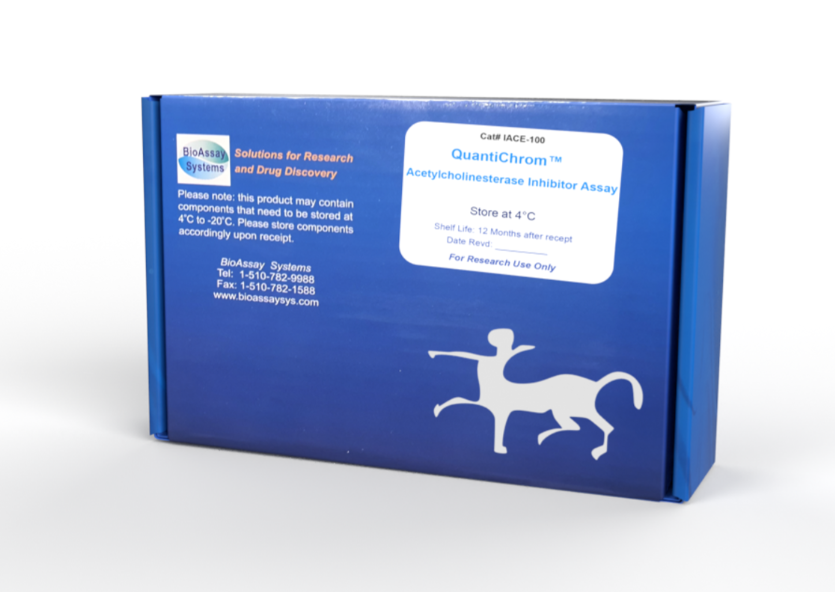DESCRIPTION
ACETYLCHOLINESTERASE (EC 3.1.1.7, AChE), also known as RBC cholinesterase, is found primarily in the blood and neural synapses. AChE catalyzes the hydrolysis of the neurotransmitter acetylcholine into choline and acetic acid, a reaction necessary to allow a cholinergic neuron to return to its resting state after activation. Inhibition of the enzyme leads to acetylcholine accumulation, hyperstimulation of nicotinic and muscarinic receptors, and disrupted neurotransmission. AChE inhibition is an important target for the management of Alzheimer’s disease and AChE inhibitors are the most common drugs used for its management. In addition to Alzheimer’s disease, AChE inhibitors have been useful in the diagnosis or treatment of diseases such as glaucoma, myasthenia gravis, bladder distention, and more. BioAssay Systems' QuantiChromTM Acetylcholinesterase Inhibitor Screening kit is based on an improved Ellman method, in which thiocholine produced by the action of acetylcholinesterase forms a yellow color with 5,5’-dithiobis(2-nitrobenzoic acid). The intensity of the product color, measured at 412 nm, is proportionate to the enzyme activity in the sample.
KEY FEATURES
Rapid and reliable. Can be completed in less than 30 minutes.
High-throughput. Homogenous “mix-incubate-measure” type assay. Can be readily automated on HTS liquid handling systems for processing thousands of samples per day.
APPLICATIONS
HTS for inhibitor screening and evaluation of acetylcholinesterase inhibitors.
KIT CONTENTS (100 TESTS IN 96-WELL PLATES)
Assay Buffer (pH 7.5) : 30 mL DTNB: 60 µL
Substrate (100mM) : 500 µL
Bulk Reagents: Custom sizes available upon request.
Storage conditions. The kit is shipped at room temperature. Store the substrate and DTNB at -20°C and all other components at room temperature upon receiving. Shelf life: 12 months after receipt
Precautions: Reagents are for research use only. Normal precautions for laboratory reagents should be exercised while using the reagents. Please refer to Material Safety Data Sheet for detailed information.
PROCEDURES
This assay is based on an enzyme-catalyzed kinetic reaction. To ensure identical incubation time, addition of Working Reagent should be quick and mixing should be brief but thorough. Use of a multi-channel pipettor is recommended. Note: Neither AChE nor a control inhibitor is included in the kit.
Sample Preparation: Dilute purified AChE to 400 U/L using assay buffer. Dissolve the test compounds in solvent of choice. If using DMSO, it is prudent to first test the tolerance of DMSO by the enzyme of choice. For AChE from E. electricus, the DMSO concentration of the 5 µL of test compounds added to the reaction should be 40 v% DMSO or less.
Reagent Preparation: Equilibrate all components to desired reaction temperature. The Working Reagent should be prepared freshly and used within 30 min.
The following protocol is optimized for AChE from E. electricus. If another species is being analyzed, we recommend that you experimentally determine the Km and then adjust the volume of substrate in the Working reagent so that the final concentration of the substrate in the 200 µL reaction is near the Km.
96-Well Plate Reaction Preparation:
1. Transfer 45 µL of AChE into separate wells. Transfer 45 µL of assay buffer into one well, this will be the No Enzyme Control well which can be used as a 100% inhibition control.
2. To the No Enzyme Control well and one well containing AChE (No Inhibitor Control), add 5 µL of solvent that the test compounds are dissolved in. For example, if the test compounds are dissolved in 40 v% DMSO, add 5 µL 40 v% DMSO to these wells.
3. To the remainder of the wells containing AChE, add 5 µL of the test compounds. Incubate the plate for 15 minutes.
4. For each reaction well, mix 154 µL Assay Buffer with 1 µL Substrate and 0.5 µL DTNB. Add 150 µL of this Working Reagent to each sample, sample blank, and no-inhibitor control wells. Tap plate to mix. (Note: Volume of Substrate can be adjusted if species other than E. electricus is being analyzed.)
5. Read OD412nm at 0 min and at 10 min in a plate reader.
CALCULATION
Acetylcholinesterase activity is calculated as follows:
Where ∆OD Test Cpd is the OD412nm value of a test compound well at 0 min subtracted from the OD412nm value of a test compound well at 10 min and ∆ODNo Inhibitor is the OD412nm value of the No Inhibitor Control well at 0 min subtracted from the OD412nm value of the No Inhibitor Control well at 10 min.
ASSAYS IN 384-WELL PLATE
The procedure is similar to the 96-well plate assay, except that 18 µL AChE sample is incubated with 2 µL inhibitor and then mixed with 30 µL Working Reagent (32 µL Assay Buffer, 0.25 µL substrate, 0.125 µL DTNB).
MATERIALS REQUIRED, BUT NOT PROVIDED
Purified AChE (e.g. Sigma Aldrich cat# C3389) and if desired a control AChE inhibitor (e.g. Physostigmine, Santa Cruz Biotechnology Cat# sc202764). Pipeting devices and accessories (e.g. multi-channel pipettor), clear flat-bottom 96-well plates (e.g. VWR cat# 82050-760), and plate reader.
Physostigmine and Donepezil titrations: AChE from E. electricus was incubated with various concentrations of Donepezil and Physostimine. Each concentration of inhibitor contained 20v% DMSO (final 0.5v% in 200 µL reaction).
PUBLICATIONS
1. Bakr, RO et al. (2021). New adenosine derivatives from aizoon canariense l.: In vitro anticholinesterase, antimicrobial, and cytotoxic evaluation of its extracts. Molecules, 26(5).
2. Ji, J et al. (2020). A polyphenol rich sugarcane extract as a modulator for inflammation and neurological disorders. PharmaNutrition, 100187.
3. El-Malah, A. et al (2019). New cyclooctathienopyridine derivatives in
the aim of discovering better Anti-Alzheimer's agents. Journal of
Molecular Structure.
